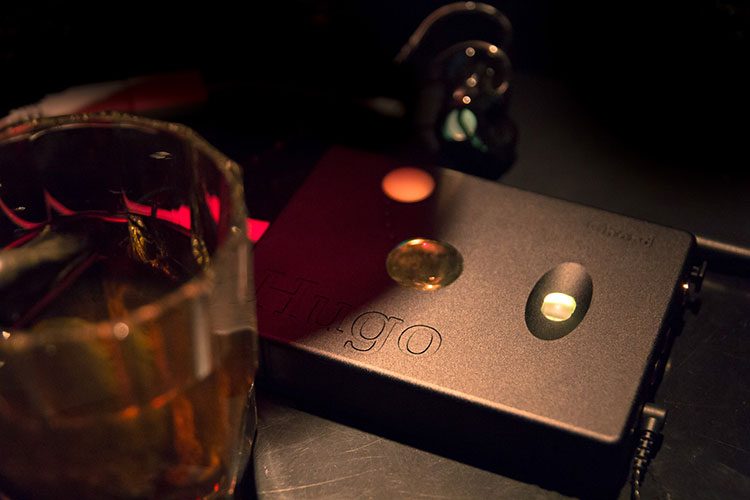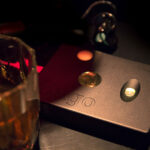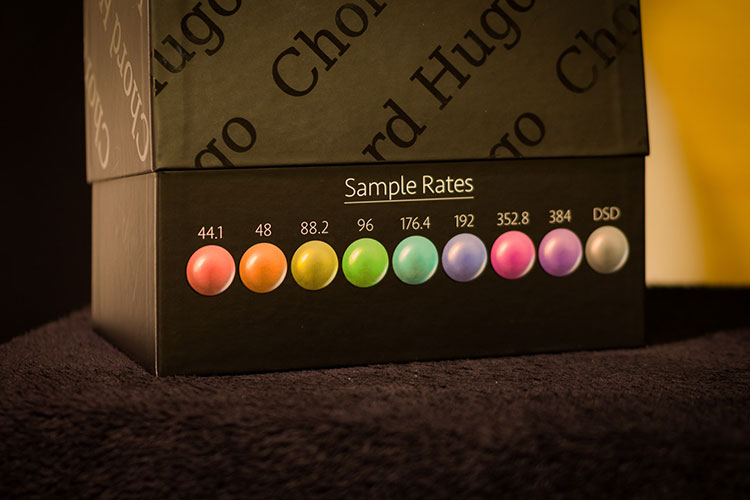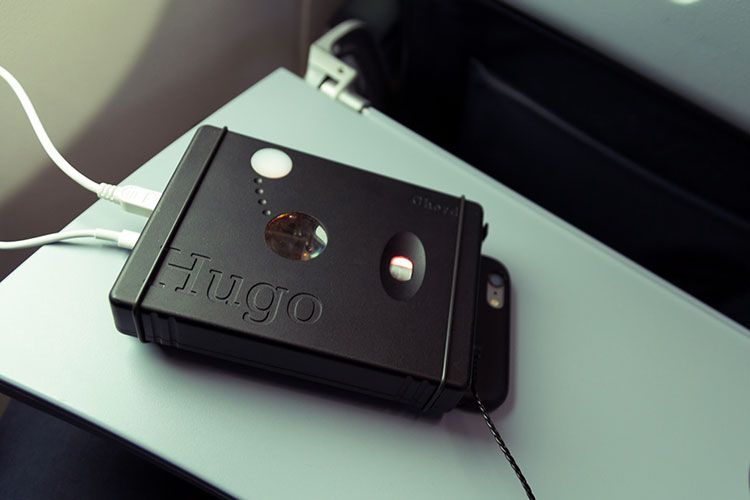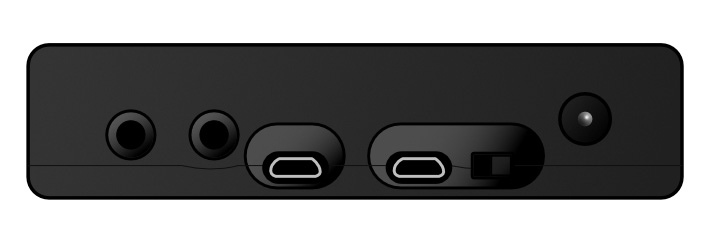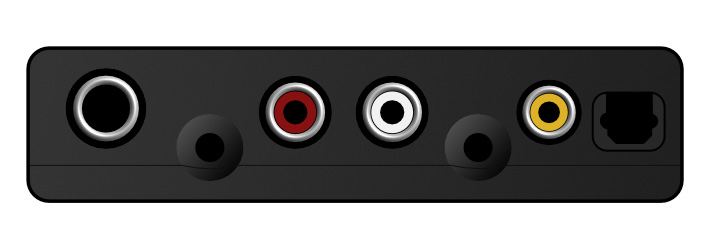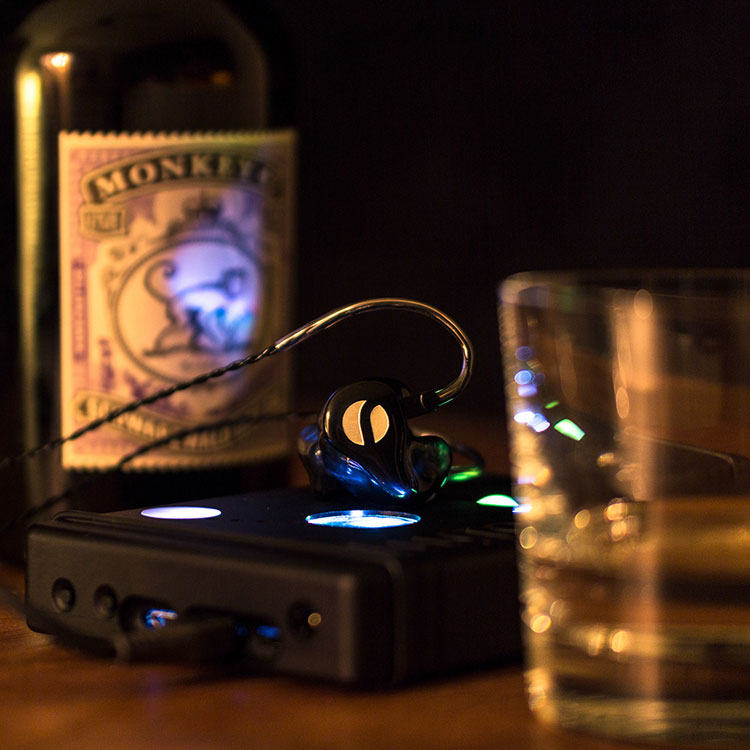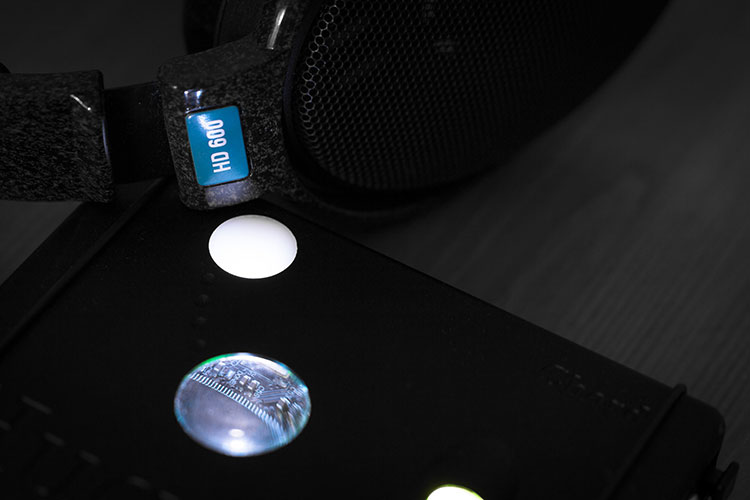The Chord Electronics Hugo is a new portable amp and DAC with A2DP aptX Bluetooth, plus advanced 384kHz PCM and DSD 128 playback. It is priced at £1,400.
Disclaimer: This sample was sent to us in exchange for our honest opinion. Headfonics is an independent website with no affiliate links or status. We thank the team at Chord Electronics for their support.
You can read more about the Chord Electronics products we have previously featured on Headfonics by clicking here.
Note that this article follows our current scoring guidelines, which you can read in more detail here.
I can’t remember a media player or portable DAC that has recently caused such hype in the audiophile hifi scene as the Chord Hugo; a quite highly-priced DAC and headphone amp with pre-out that has pushed the budget limit quite a bit for many in a growing niche market. Let’s take a look at the phenomenon called Hugo.
Features
Hugo is wordplay; a phonetic pun on the phrase “everywhere you go” … where you-go… hu-go… Hugo. I filed this under British humor (see what I did there?), which can sometimes be uneasy to get into.
Portability
Anyway, the product name emphasizes the portable aspect of this handy DAC, which is its core feature, well, not the portable aspect alone, its prowess that matches mid to high-tier home setups that fit into your larger pocket.
The size (approx. 13 x 10 x 2,5cm at 0.4 kg) might be a bit off-putting at first, but eventually, you will make sure you always find space in your bag to take it along.
More like a fully spec’d personal computer, this DAC will make sure it is future-proof and will boost the sound quality of all your transportable devices. Inputs are covered well with USB, Toslink, and Coax, the outputs are surprisingly high in quantity. If you dislike cables, use Bluetooth.
Next to the regular stereo RCA output, there is a button combination to activate line-level volume output for a serious home listening experience. When looking at Hugo, we are also looking at an extremely potent headphone amplifier with 2x 3,5mm and one 6,3mm headphone jack.
Yep, three headphone outputs… simultaneously. If you were wondering, the output impedance measures around 0,075 ohms. This is fantastic for in-ear headphones with multiple drivers.
If the impedance is too high, the power is not distributed equally to the individual drivers thus bending the frequency response. Most audiophiles will try to stay below 1 ohm.)
Crossfeed Filter
The icing on the cake is the crossfeed filter. Surely a feature some will be happy to use. So aside from versatility, what muscles have to be flexed to achieve high popularity in a fairly niche high-end market? A DAC that handles 32-bit 384 kHz DXD and everything lower with ease; that’s what.
Practically pro-audio studio monitoring quality for your bus ride to work, considering you have the necessary high-end headphones or high-end output amp with speakers with you.
Companies are quick to boast specs and advertise DSD playback nowadays but only a few can boast to run a Spartan 6 FPGA processor as Hugo has. Chord emphasizes the extremely competent WTA filters in use.
Filtering
I quote from the website: “44.1 kHz sampling can be capable of accurately resolving transients by the use of digital filtering. Digital filtering can go some way towards improving resolution without the need for higher sampling rates.
To do this the filters need to have infinite long tap lengths.” Chord claims that the largest commercial device has only about 256 taps – compared to Hugo who boasts 26k.
Inputs
If you are wondering which input to use, here are some points to consider:
There are two USB inputs. One is for asynchronous 16, 24, and 32-bit HD (up to 384 kHz), and the other is your default 16-bit (44,1 or 48 kHz). It might be confusing at first, but the reason for the lower spec’d input makes sense because it works with my Apple iPhone (and Android, obviously).
Since my iPhone 6 Plus isn’t big enough already, I strapped it to Hugo. Good thing somebody called me on my phone number because when I finally held that big black combo to my ear, I saw relief in all eyes laid on me.
Because who would hold a bomb to their ear? Jokes aside, this is a very handy feature to have, although I mostly use the HD USB.
Bluetooth
Bluetooth is also limited to 16 Bit 48 kHz, just like the SD USB. The A2DP/ APTX technology is supposed to have a range of up to 20m. I admit I cannot confirm the distance. My room isn’t that long and if I go into the next room, the sound cuts off or stutters. As long as I stay in the same room of approximately 40m^2, there are no issues.
If your source does not have USB-out and if you are still wondering whether TosLink or Coax is the better digital cable for you, consider that the optical input is limited to 192 kHz whereas the BNC type Coax will give you the full 384 kHz range, both with 24 Bit
Packaging & Design
Packaging
Chord ships the Hugo in a sturdy cardboard box. It’s neither flashy nor tacky, just humble with a few design details. The top cover has black “Chord Hugo” printing on solid black background, the bottom lists the features and reminds you that the product is made in England by Chord Electronics Ltd.
When you lift the top, both sides of the bottom cardboard box will show you the instructions and how to interpret the intuitive color code of Hugo. The device itself is held nicely in place by foam material with multiple layers – the first one gives you a little sneak peek at Hugo!
Accessories
Underneath the Hugo, you will find a Coax adapter and a Chord USB stick with drivers including a digital copy of the manual, although my unit came with printed manuals both in English and German. Lift the inner velour-coated plastic separation to find the accessories. Accessories include:
- 6 rubbers that serve as bumpers but can also be used to hold your iPhone in place, for example.
- 3 x Toslink optical cables with two being short (3,5mm and default termination) and a longer optical cable for home use.
- 3 x USB with two short cables (micro-USB and default termination) and a longer cable for desktop PCs.
- A dedicated charger with an electric plug only.
Design
Hugo himself is strong like a tank. Or even stronger? Watch Stefan Schickedanz roll over Hugo in a 13-ton tank on YouTube and you will get my point.
Yes, that’s an incredibly well-built aluminum housing protecting the finest hand-assembled technology. The bottom has four hard rubbery bumpers to prevent scratches when laying on surfaces.
To make it short, my unit didn’t show even the tiniest flaws in production quality or quality control. Every screw is as tight as it should be, all input and output connections are firmly in place, and the two push buttons on the back have a solid and tactile feel to them.
I chose the black version of Hugo that was released a while after the launch. You best refer to the pictures to decide whether you can dig his design. Hugo certainly features a very original look with a tendency to appeal to tech nerds.
Glass Window
A circular glass window allows a view into the technology inside. This feature serves a purpose as it shows multiple colored LED lights for several indications from the battery, source, crossfeed, and line output.
Depending on the viewing angle, these might not be perfectly centered in the middle but easy to find. Hugo likes to show off glowing lights. There is a separate white-layered space with colored LEDs to inform you about the sample rate of your source. How cool is that?
Volume Control
But the actual showstopper is the unique volume control. It’s embedded in an oval form and allows careful volume adjustment via a solid knob that also glows in the colors according to the volume.
Chord does know how much men like to play with knobs (there is a dedicated YouTube channel for that) and they did a perfect job there. If you are using Hugo in a dim environment, he will positively draw your attention.
Personally, I like how the names Chord and Hugo are punched into the aluminum housing, Chord is self-confident enough not to plaster their name on the device, yet there will be very few people confusing Hugo with another DAC or amp.
The Manual
I know, I know. There is a manual included with every Chord Hugo. But let’s be honest: who wants to read the manual when he unpacks a fresh new device? Nobody has time for that!
But on the other hand, if you are reading this review, chances are high that you don’t have a Hugo yet. So here’s my take on a simplified user guide so you know right away how to use Hugo when you hold it in your hands for the first time – at home or a meeting.
If you’re a Windows user, you will have to install the included drivers on the provided USB stick. If you’re an Apple user, you can plug and play.
Rear Panel
This is the backside. The power button is easy to find. Once you remember that the HD USB is close to the power switch while the SD USB is by itself, there should not be any questions about the input connections.
The button on the far left toggles the various inputs. It defaults to HD USB after every boot. The cycle goes as follows:
- HD USB > SD USB > Toslink > Coax > Bluetooth > HD USB
The button next to it toggles crossfeed at various levels. The cycle goes:
- off > minimum > medium > maximum > off
Front Panel
The front side has all outputs (3x headphones, 1x RCA), and the remaining inputs with optical and coaxial. So basically, what just sounded so complex is very simple. Volume, input, and crossfeed reset after every reboot.
Once you switch on the power, you hit the input button until the indication for the sample rate glows up. Per preference, you might hit the crossfeed button one to three times and adjust the volume accordingly. That’s it.
Sound Impressions
Describing sound signatures of DACs or amplifiers can be difficult at times; especially in this case. I would love to throw charming words around but I have to be careful to stay accurate. The terms “musical”, “lush” and “warm” apply as little as vocabulary like “analytical” or “bright.” How do you describe something of which there is none?
The DAC
The DAC part is simply outstanding. I’m not rich and I don’t collect hifi-setups. I usually stick with what I need and which serves me best from an audiophile standpoint (I do have various fields of application, mind you).
However, I never miss a chance to go to hifi meets and exhibitions and I’ve been in this business for quite a while. So there is some weight to my following claim: The Chord Hugo DAC has the most realistic and organic feel I have yet experienced in the portable hifi world. I can’t notice added warmth, no analytical emphasis, no stretched soundstage, or added musicality.
Analog Feel
But at the same time, Hugo is not brutally honest. He has some magical analog feel with a very realistic rendering of all voices and instruments. Depending on the audio mastering, the output may either be bright or warm always having the DAC part do its best to go unnoticed.
In the final stages of my review, I have used Hugo mostly in my stereo speaker setup at home. Feeding my grandfather’s vintage Onkyo amp, he was extremely capable of rendering all inputs accurately.
Scaling
16Bit sources sound fantastic already. Hugo can even make AAC and MP3 shine, although, – when compared to their high-resolution studio recordings – I noticed that bass texture could be improved a wee bit to achieve a level of full transparency.
I will not claim to hear the difference between 24 and 32 Bit and one of my best recordings is probably Thriller in DSD, next to several Classical recordings like last year’s release of Tchaikovsky’s Manfred Symphony directed by Pletnev (a personal favorite, go check it out).
But it doesn’t matter if I use full-size headphones, custom in-ear, or just the analog output; Hugo scales effortlessly and delivers exactly what I hope for. It is hard to imagine that a small black aluminum box could potentially find its firm spot in a home setup.
Bass Critique
If I had to point out any area that leaves room for improvement – if my life depended on it – I would be asking for a crisper and rougher textured bass. However, this demand is not eligible since I haven’t heard better about portable hifi yet.
You have to know your equipment very well to notice which link of a chain has which effect. Hugo covers two links at once since it only allows digital inputs.
The Amp
Judging the headphone amplifier unit alone is a difficult task but I was able to do so by using the analog outputs feeding other amps. Needless to say, there is a high chance that Hugo’s DAC unit will boost whichever analog head-amp you connect it to.
To start, I’m an IEM guy although I don’t review in-ears. Nevertheless, that’s my comfort zone and CIEMs are my most important area for portable use. Using Hugo for multi-driver IEMs is like sailing on a dreamboat.
Output impedance is ridiculously low, there is no audible background noise even on maximum volume and the volume adjustment is precise and perfectly balanced even at very low levels.
Power
Be advised to turn down the volume knob to red and then some, because when Hugo flexes his muscles, he can shout extremely loud! Loud enough to power any headphones I have thrown at it.
I was lucky enough to take Hugo with me to this year’s Munich High-End show and to try out a broad range of headphones. I wasn’t able to achieve a volume level at which any headphone would distort. I wouldn’t mind further examining this with some of the toughest headphones out there.
If you are willing to power an Abyss and this falls into the portable category for you (possible situation: a business trip with a lengthy stay at a hotel), you might have to do some further research. I was not lucky enough to test this setup yet.
Accurate
Hugo’s head-amp continues the path of his DAC unit. It delivers accurate and realistic rendering with basically no coloration. Tonality is just exemplary. Before Hugo, my references have been desktop amps by Meier Audio.
Now they sound a wee bit bright and lightweight to my ears. I noticed a trend recently that many amps (or portable media players) will sound warmer to various degrees. Hugo is much closer to what I consider truly realistic, though.
Bass
Bass is well rounded and very controlled even with the most precise in-ear monitors. Listening to Electronica is a wonderful experience and Hugo does a wonderful job of reproducing the Artist’s tracks – although at times it means too much or too little bass quantity, depending on the source. I haven’t come across a Thrash Metal track yet that would make Hugo sweat.
Mids
I repeat myself, but I can’t help it: voices are extremely realistic. There is no coloration and they set themselves apart nicely, even if the recording is originally crowded (Garage Rock, anyone?). Be it Gregory Portman’s low or Christina Aguilera’s high voice, there is not any sign of blending into other instruments or recorded tracks.
Treble
I hate to say this because it’s an overly used term for marketing, but highs are silky smooth. They really are. There is no reason to take it away from Hugo just because every audio product claims it. They are never harsh but always crisp enough to squeeze out the smallest details. Bravo!
Soundstage
The soundstage is not overly expansive. It is just right to portray intimacy in voices while never feeling intrusive or forward. Hugo scales wonderfully with the source. This especially shows with Classical albums that have great depth and layering.
Overall, the best quality any DAC or amp can have is to go unnoticed or not attract attention. Hugo does just that. I did my best to describe a sound that I couldn’t hear. The output is transparent enough on a level that the portable hifi market simply has to appreciate.
Crossfeed
Chord gave Hugo a neat feature that I use more than I initially thought. Crossfeed mixes both channels to a small degree to blend the left and right channels for a more natural feel. Not everybody is a fan of crossfeed and many prefer a strict separation of left and right.
But in this case, I recommend to give it a try nonetheless. Older recordings have a too strong separation, which doesn’t allow an accurate soundstage in my opinion. With Nina Simone, for example, I noticed I enjoyed the maximum setting.
The crossfeed (or X-feed) is very well implemented. The average setting is similar to Corda Jazz’s crossfeed (which only has on and off). I prefer the minimum setting in most cases, especially when using CIEMs. It does feel very natural and I can’t notice any decrease in resolution or tightness at this setting whatsoever.
Using crossfeed will lower the bass’ impact, though, as the sound pressure will be distributed more equally. Depending on the recording, it might go unnoticed altogether.
The Flaws
Yup, this is a new category now. Usually, I’d go with a sandwich criticism strategy in which I say something good, then something bad, and finally something good again. However, the flaws are so minor that they would have gone completely unnoticed within this review, so I decided in favor of a dedicated paragraph.
Power Button
First of all, the power button is difficult to access because it’s too deep in the body. It’s a very small hard-edged slider. I would have preferred a push button. Since I already have long thin fingers, I can imagine some people will have difficulties reaching it.
3.5mm Jacks
Secondly, the 3.5mm jacks have a similar problem. Some right angular headphone terminations might not get deep enough to reach the jack. I see many pictures of Hugo popping up on various social platforms with angled cables having to use a 6,3mm adapter.
USB Inputs
Thirdly, both USB input connections have too much space. The included cables wiggle around very slightly and I just don’t have that satisfactory feel when sticking it in.
I know it’s minor, but details can matter. I want to push past a light resistance to eventually slide in smoothly after passing the hurdle so that I can feel the connection is safely in place. This is exactly the case with the 6.35mm jack and I demand more of this high-end connection quality!
EMI
Furthermore, Hugo has the same problem as any portable amp I have ever tried: It picks up low-frequency telecommunication transmissions. If a smartphone is close by it struggles to have a good signal, therefore it jumps down to Edge or GPRS technology, and you can hear electromagnetic interference through your headphones.
This is an issue that I perceive with all amps so far, but perhaps Chord can think about using a similar EMI shielding as smartphones have for their next device so that train rides can be even more enjoyable.
Battery Life
Finally, these technically aren’t flaws but who wouldn’t mind a longer battery life? I also wish the optical input connection wouldn’t have a removable protection cap that can get lost easily. Of course, the sensitive technology must be protected, but there are devices like the Sony PlayStation 3 and 4 that have valves for that.
If Hugo could be charged via USB too, that would also save some space and cables one has to carry around. And I wouldn’t mind if a coax cable were included.
Our Verdict
Following my short paragraph on flaws, I have to stress that the Chord Hugo DAC and head-amp is an absolute killer device. But you already knew that because people have probably been telling you that for a while now. It’s the Swiss army knife among portable DACs and it has an incredible headphone output (well, three) as well.
Build quality is superb, too. But most of all, the sound is very truthful to the source with an organic and realistic feel like I have rarely felt. The crossfeed network is implemented perfectly and overall Hugo is capable of putting many home set-ups to shame while neatly fitting into most pockets. This is reference material!
Chord Electronics Hugo Technical Specifications
Inputs
- Optical TOSLink 24-bit/192kHz-capable
- RCA coaxial input 24-bit/384kHz-capable
- Driverless USB input 16-bit/48kHz-capable (designed for tablets/phones)
- HD USB input 32-bit/384KHz and DSD128-capable (for computer/laptop playback; requires driver installation on Windows, others TBC)
Outputs
- 2×3.5mm headphone jacks
- 1×6.35mm (1/4 inch) headphone jack
- 1x (pair) stereo RCA phono output
Other Specs
- Advanced digital volume control
- Crossfeed filter network
- Battery-powered for approximately 14 hours of operation
- Input, sample rate, and volume level indication by color-change LEDs
- 26K tap-length filter (more than double when compared to the QuteHD DAC)
- THD: 140dB
- Headphone output: 110dB SPL into a 300Ω headphone load




